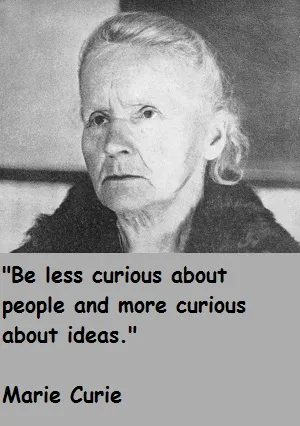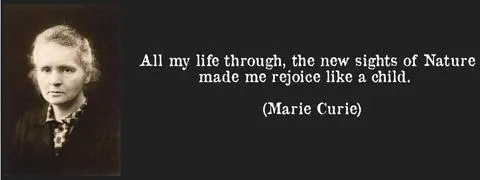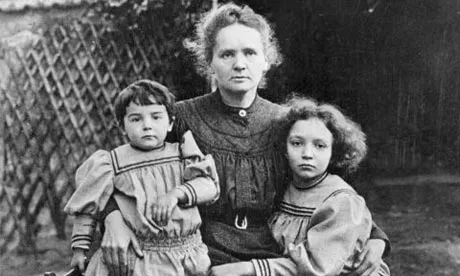Marie Curie: A look back on the life and times of the greatest scientist that ever lived
You cannot hope to build a better world without improving the individuals. To that end,each of us must work for our own improvement and, at the same time, share a genaral responsibility for all humanity, our particular duty being to aid those to whom we think can be most useful: Marie Curie
Ever heard of anyone (even if they are women) referring to someone insanely clever as Curie? Ever heard of clever people being referred to as Einstein? Every analogy of cleverness is attributed to Einstein- a great scientist no doubt, but not the only one of his ilk. Madame Marie Curie had stumbled upon Einstein’s great discovery long before he did. A short, but much deserved look back, at the great scientist’s life and the struggles that were thrust her way simply because she was a woman.

Considering the famed prodigy that she was, Mare Curie stumbled upon the most seminal discovery of her life- radioactivity- in a rather curious and accidental sort of way. In the February of 1896 professor Henry Becquerel, a famed French scientist, was in the midst of an interesting experiment which involved exposing uranium crystals to the sunlight for a length of time and then placing the object on a photographic plate. This was being done to deduce the phosphorescence in uranium salts. As he had hypothesized, the crystal imprinted its image on the plate. Becquerel assumed this was the energy of the sun being converted to x rays by the uranium. Subsequently he put all the equipment, uranium and plate and all, because the weather was playing spoilsport and the sun was nowhere to be seen. When he retrieved them a few days later he was startled to find the crystals emitting glowing rays, even in the absence of any energy source.
Baffled, he thought the rays were caused by some sort of spontaneous emission by the uranium and left it at that. Fortunately, he thought to turn over the abandoned project to a particularly gifted student in his graduate class by the name of Marie Sklodowska Curie. Ten years later Einsten would correctly identify the phenomenon at work here- the rocks were converting mass into energy very efficiently. The nucleus of the unstable atom of the uranium crystal was losing energy by emitting particles of ionized radiation. Though Madame Curie was not privy to this fact in 1896, she knew she had stumble onto something infinitely priceless.

Marie Sklodowska had recently emigrated from Poland and had been married for less than a year to Pierre Curie when this fateful incident occurred. The husband wife team experimented extensively on uranium ore objects and coined the term “radioactivity” to refer to the emissions that formed the core of their study. They also decided to investigate what other matter exhibited this activity, zeroing in on Thorium. While comparing the properties of pure uranium with that of uranium ore, they discovered that the latter sample exhibited significantly more radiation than the former. The mineral pitchblende was emitting stronger rays than pure uranium only because it contained highly reactive unknown substances. This led her to discover two radioactive elements. One she named Polonium after her native homeland, the other was christened Radium.
It is ironic that she chose to honour her homeland thus, because the very reason she chose to come to France is because she was denied every opportunity to follow her passion for science in Poland. She turned down Pierre Curie’s proposal of marriage initially, even though she held him in deep regard, because she assumed she would be going back home when her projects in France were complete. It is another matter entirely that Pierre passionately declared he would move to Poland with her, if that’s what it took. In 1894, after earning prestigious degrees, she returned to Warsaw to contemplate her chances there. But when she was denied a place at the University of Krakow because she was a woman, she returned to France permanently and embarked on one of the most illustrious careers in the history of science.

In 1903 Madame Curie became the first woman to win a Nobel Prize when she shared one half of the award in physics for the discovery of radioactivity with her husband Pierre. In 1910 she published her fundamental treatise on Radioactivity. The other half was awarded to Henry Becquerel. In 1911 she multiplied her earlier feat by being the sole winner of the Nobel Prize in chemistry for the discovery of Polonium and Radium, thus becoming the only person to be awarded the elusive medal in multiple sciences.
Marie Curie’s exhaustive body of work is studded with international medals, awards and other notable recognitions. However, even after two Nobels under her belt, she was denied many an honours simply for being a woman. These went to men who were significantly less qualified than her. Case in point is when she was defeated by a mere two votes to succeed the position left vacant by Gernez in the French Academy of Sciences. This happened in 1911, the very year she won her second Nobel Prize in chemistry!
But the remarkable woman did not let this deter her work. She went on to help found the famous Radium Institute of the University of Paris in 1914. She had already become the first woman to teach at Sorbonne in 1906, though this came about via tragic circumstances. Pierre Curie was killed in a carriage accident while crossing the street in April 19th 1906, and it was his professorship that she succeeded. Marie Curie was determined to devoting her life to the work that she and her husband had partnered together so successfully. With the advent of World War I she became fanatically immersed in finding practical medical applications for radioactivity.

Her daughter Irene Curie was now an integral part of her research team. The Radium Institute became the hub of pioneering nuclear physics and chemistry research. The development of X Radiography was her most notable accomplishment this period. From 1921 onwards she travelled all over the world, giving speeches and demonstrating her work. The American President Warren Harding presented her with one gram of radium, in recognition of her immense contribution to science, when she journeyed to USA.
The damaging effects of radium were not known when Marie Curie was working with them. She carried radioactive isotopes in her pocket, kept samples in her desk drawers and in general was exposed to every harmful aspect of it in the course of her research. She was not the only one. Manufacturers assumed that something as wondrous as radioactivity had to be full of benefits for the human kind. Radioactive substances were put in toothpastes, laxatives and all manner of household goods and products. Hotels and resorts proudly advertised their therapeutic radioactive mineral springs. Madame Curie contracted Leukaemia from her lifelong exposure to radioactive substances and died in 1934. The mal-effects of radiation are so deadly that all her original research papers and stationery, even her personal items like clothing and cookbooks, are very dangerous to touch. Her lab books are preserved in lead lined boxes. Those wishing to handle them have to don layers of protective clothing to be permitted even in the vicinity of the Curie sanctuary.







